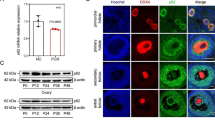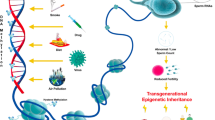Abstract
It has been well established that uterine function during the peri-implantation period is precisely regulated by ovarian estrogen and progesterone. The embryo enters the uterine cavity before implantation. However, the impact of pre-implantation embryo on uterine function is largely unknown. In the present study, we performed RNA-seq analysis of mouse uterus on day 4 morning of natural pregnancy (with embryos in the uterus) and pseudo-pregnancy (without embryos in the uterus). We found that 146 genes were upregulated, and 77 genes were downregulated by the pre-implantation embryo. Gene ontology and gene network analysis highlighted the activation of inflammatory reaction in the uterus. By examining the promoter region of differentially expressed genes, we found that NF-kappaB was a causal transcription factor. Finally, we validated 4 inflammation-related genes by quantitative RT-PCR. These 4 genes are likely the main mediators of the inflammatory reaction in the uterus triggered by the pre-implantation embryo. Our data indicated that the pre-implantation embryo causes uterine inflammatory reaction, which in turn might contribute to the establishment of uterine receptivity and embryo implantation.






Similar content being viewed by others
References
Wang H, Dey SK. Roadmap to embryo implantation: clues from mouse models. Nat Rev Genet. 2006;7(3):185–99. https://doi.org/10.1038/nrg1808.
Wilcox LS, Peterson HB, Haseltine FP, Martin MC. Defining and interpreting pregnancy success rates for in vitro fertilization. Fertil Steril. 1993;60(1):18–25.
Zinaman MJ, Clegg ED, Brown CC, O'Connor J, Selevan SG. Estimates of human fertility and pregnancy loss. Fertil Steril. 1996;65(3):503–9.
Macklon NS, Stouffer RL, Giudice LC, Fauser BC. The science behind 25 years of ovarian stimulation for in vitro fertilization. Endocr Rev. 2006;27(2):170–207. https://doi.org/10.1210/er.2005-0015.
Zhang S, Lin H, Kong S, Wang S, Wang H, Wang H, et al. Physiological and molecular determinants of embryo implantation. Mol Asp Med. 2013;34(5):939–80. https://doi.org/10.1016/j.mam.2012.12.011.
Stewart CL, Kaspar P, Brunet LJ, Bhatt H, Gadi I, Kontgen F, et al. Blastocyst implantation depends on maternal expression of leukaemia inhibitory factor. Nature. 1992;359(6390):76–9. https://doi.org/10.1038/359076a0.
Bagot CN, Kliman HJ, Taylor HS. Maternal Hoxa10 is required for pinopod formation in the development of mouse uterine receptivity to embryo implantation. Dev Dyn. 2001;222(3):538–44. https://doi.org/10.1002/dvdy.1209.
Gendron RL, Paradis H, Hsieh-Li HM, Lee DW, Potter SS, Markoff E. Abnormal uterine stromal and glandular function associated with maternal reproductive defects in Hoxa-11 null mice. Biol Reprod. 1997;56(5):1097–105.
Daikoku T, Cha J, Sun X, Tranguch S, Xie H, Fujita T, et al. Conditional deletion of Msx homeobox genes in the uterus inhibits blastocyst implantation by altering uterine receptivity. Dev Cell. 2011;21(6):1014–25. https://doi.org/10.1016/j.devcel.2011.09.010.
Lee K, Jeong J, Kwak I, Yu CT, Lanske B, Soegiarto DW, et al. Indian hedgehog is a major mediator of progesterone signaling in the mouse uterus. Nat Genet. 2006;38(10):1204–9. https://doi.org/10.1038/ng1874.
Liu JL, Zhao M, Peng Y, Fu YS. Identification of gene expression changes in rabbit uterus during embryo implantation. Genomics. 2016;107(5):216–21. https://doi.org/10.1016/j.ygeno.2016.03.005.
Wang Z, Gerstein M, Snyder M. RNA-Seq: a revolutionary tool for transcriptomics. Nat Rev Genet. 2009;10(1):57–63. https://doi.org/10.1038/nrg2484.
Mortazavi A, Williams BA, McCue K, Schaeffer L, Wold B. Mapping and quantifying mammalian transcriptomes by RNA-Seq. Nat Methods. 2008;5(7):621–8. https://doi.org/10.1038/nmeth.1226.
Garber M, Grabherr MG, Guttman M, Trapnell C. Computational methods for transcriptome annotation and quantification using RNA-seq. Nat Methods. 2011;8(6):469–77. https://doi.org/10.1038/nmeth.1613.
Schroeder A, Mueller O, Stocker S, Salowsky R, Leiber M, Gassmann M, et al. The RIN: an RNA integrity number for assigning integrity values to RNA measurements. BMC Mol Biol. 2006;7:3. https://doi.org/10.1186/1471-2199-7-3.
Huang MY, Zhang WQ, Zhao M, Zhu C, He JP, Liu JL. Assessment of embryo-induced transcriptomic changes in hamster uterus using RNA-Seq. Cell Physiol Biochem. 2018;46(5):1868–78. https://doi.org/10.1159/000489371.
Trapnell C, Pachter L, Salzberg SL. TopHat: discovering splice junctions with RNA-Seq. Bioinformatics. 2009;25(9):1105–11. https://doi.org/10.1093/bioinformatics/btp120.
Trapnell C, Williams BA, Pertea G, Mortazavi A, Kwan G, van Baren MJ, et al. Transcript assembly and quantification by RNA-Seq reveals unannotated transcripts and isoform switching during cell differentiation. Nat Biotechnol. 2010;28(5):511–5. https://doi.org/10.1038/nbt.1621.
Huang DW, Sherman BT, Tan Q, Kir J, Liu D, Bryant D, et al. DAVID bioinformatics resources: expanded annotation database and novel algorithms to better extract biology from large gene lists. Nucleic Acids Res. 2007;35(Web Server issue):W169–75. https://doi.org/10.1093/nar/gkm415.
Szklarczyk D, Morris JH, Cook H, Kuhn M, Wyder S, Simonovic M, et al. The STRING database in 2017: quality-controlled protein-protein association networks, made broadly accessible. Nucleic Acids Res. 2017;45(D1):D362–d8. https://doi.org/10.1093/nar/gkw937.
Assenov Y, Ramirez F, Schelhorn SE, Lengauer T, Albrecht M. Computing topological parameters of biological networks. Bioinformatics. 2008;24(2):282–4. https://doi.org/10.1093/bioinformatics/btm554.
Zhao M, Zhang WQ, Liu JL. A study on regional differences in decidualization of the mouse uterus. Reproduction. 2017;153(5):645–53. https://doi.org/10.1530/REP-16-0486.
Koskinen P, Toronen P, Nokso-Koivisto J, Holm L. PANNZER: high-throughput functional annotation of uncharacterized proteins in an error-prone environment. Bioinformatics. 2015;31(10):1544–52. https://doi.org/10.1093/bioinformatics/btu851.
Yu G, Lu C, Wang J. NoGOA: predicting noisy GO annotations using evidences and sparse representation. BMC Bioinformatics. 2017;18(1):350. https://doi.org/10.1186/s12859-017-1764-z.
Bromfield JJ. Seminal fluid and reproduction: much more than previously thought. J Assist Reprod Genet. 2014;31(6):627–36. https://doi.org/10.1007/s10815-014-0243-y.
Robertson SA, Mau VJ, Tremellen KP, Seamark RF. Role of high molecular weight seminal vesicle proteins in eliciting the uterine inflammatory response to semen in mice. J Reprod Fertil. 1996;107(2):265–77.
Robertson SA. Seminal fluid signaling in the female reproductive tract: lessons from rodents and pigs. J Anim Sci. 2007;85(13 Suppl):E36–44. https://doi.org/10.2527/jas.2006-578.
Austin CR. Fate of spermatozoa in the uterus of the mouse and rat. J Endocrinol. 1957;14(4):335–42.
Katila T. Post-mating inflammatory responses of the uterus. Reprod Domest Anim. 2012;47(Suppl 5):31–41. https://doi.org/10.1111/j.1439-0531.2012.02120.x.
Ma WG, Song H, Das SK, Paria BC, Dey SK. Estrogen is a critical determinant that specifies the duration of the window of uterine receptivity for implantation. Proc Natl Acad Sci U S A. 2003;100(5):2963–8. https://doi.org/10.1073/pnas.0530162100.
Liu JL, Zhang WQ, Zhao M, Huang MY. Integration of transcriptomic and metabolomic data reveals enhanced steroid hormone biosynthesis in mouse uterus during decidualization. Proteomics. 2017;17(19). https://doi.org/10.1002/pmic.201700059.
He JP, Zhao M, Zhang WQ, Huang MY, Zhu C, Cheng HZ, et al. Identification of gene expression changes associated with uterine receptivity in mice. Front Physiol. 2019;10:125. https://doi.org/10.3389/fphys.2019.00125.
Ristimaki A. Cyclooxygenase 2: from inflammation to carcinogenesis. Novartis Found Symp. 2004;256:215–21 discussion 21–6, 59–69.
Chakraborty I, Das SK, Wang J, Dey SK. Developmental expression of the cyclo-oxygenase-1 and cyclo-oxygenase-2 genes in the peri-implantation mouse uterus and their differential regulation by the blastocyst and ovarian steroids. J Mol Endocrinol. 1996;16(2):107–22.
Lim H, Paria BC, Das SK, Dinchuk JE, Langenbach R, Trzaskos JM, et al. Multiple female reproductive failures in cyclooxygenase 2-deficient mice. Cell. 1997;91(2):197–208.
Wang H, Ma WG, Tejada L, Zhang H, Morrow JD, Das SK, et al. Rescue of female infertility from the loss of cyclooxygenase-2 by compensatory up-regulation of cyclooxygenase-1 is a function of genetic makeup. J Biol Chem. 2004;279(11):10649–58. https://doi.org/10.1074/jbc.M312203200.
Ramadas RA, Ewart SL, Iwakura Y, Medoff BD, LeVine AM. IL-36alpha exerts pro-inflammatory effects in the lungs of mice. PLoS One. 2012;7(9):e45784. https://doi.org/10.1371/journal.pone.0045784.
Foster AM, Baliwag J, Chen CS, Guzman AM, Stoll SW, Gudjonsson JE, et al. IL-36 promotes myeloid cell infiltration, activation, and inflammatory activity in skin. J Immunol. 2014;192(12):6053–61. https://doi.org/10.4049/jimmunol.1301481.
Kuang H, Chen Q, Zhang Y, Zhang L, Peng H, Ning L, et al. The cytokine gene CXCL14 restricts human trophoblast cell invasion by suppressing gelatinase activity. Endocrinology. 2009;150(12):5596–605. https://doi.org/10.1210/en.2009-0570.
Kuang H, Chen Q, Fan X, Zhang Y, Zhang L, Peng H, et al. CXCL14 inhibits trophoblast outgrowth via a paracrine/autocrine manner during early pregnancy in mice. J Cell Physiol. 2009;221(2):448–57. https://doi.org/10.1002/jcp.21877.
Mokhtar NM, Cheng CW, Cook E, Bielby H, Smith SK, Charnock-Jones DS. Progestin regulates chemokine (C-X-C motif) ligand 14 transcript level in human endometrium. Mol Hum Reprod. 2010;16(3):170–7. https://doi.org/10.1093/molehr/gap100.
Schmitz JM, McCracken VJ, Dimmitt RA, Lorenz RG. Expression of CXCL15 (Lungkine) in murine gastrointestinal, urogenital, and endocrine organs. J Histochem Cytochem. 2007;55(5):515–24. https://doi.org/10.1369/jhc.6A7121.2007.
Genbacev OD, Prakobphol A, Foulk RA, Krtolica AR, Ilic D, Singer MS, et al. Trophoblast L-selectin-mediated adhesion at the maternal-fetal interface. Science. 2003;299(5605):405–8. https://doi.org/10.1126/science.1079546.
Griffith OW, Chavan AR, Protopapas S, Maziarz J, Romero R, Wagner GP. Embryo implantation evolved from an ancestral inflammatory attachment reaction. Proc Natl Acad Sci U S A. 2017;114(32):E6566–e75. https://doi.org/10.1073/pnas.1701129114.
Liu JL. Implantation in eutherians: which came first, the inflammatory reaction or attachment? Proc Natl Acad Sci U S A. 2018;115(1):E1–e2. https://doi.org/10.1073/pnas.1716675115.
Griffith OW, Chavan AR, Protopapas S, Maziarz J, Romero R, Wagner GP. Reply to Liu: inflammation before implantation both in evolution and development. Proc Natl Acad Sci U S A. 2018;115(1):E3–e4. https://doi.org/10.1073/pnas.1717001115.
Dominguez F, Pellicer A, Simon C. The human embryo proteome. Reprod Sci. 2009;16(2):188–90. https://doi.org/10.1177/1933719108328612.
Gardner DK, Harvey AJ. Blastocyst metabolism. Reprod Fertil Dev. 2015;27(4):638–54. https://doi.org/10.1071/RD14421.
Zhang Q, Lenardo MJ, Baltimore D. 30 years of NF-kappaB: a blossoming of relevance to human pathobiology. Cell. 2017;168(1–2):37–57. https://doi.org/10.1016/j.cell.2016.12.012.
Luo L, Li DH, Li XP, Zhang SC, Yan CF, Wu JF et al. Polymorphisms in the nuclear factor kappa B gene association with recurrent embryo implantation failure. Genet Mol Res. 2016;15(2). https://doi.org/10.4238/gmr.15027759.
Nakamura H, Kimura T, Ogita K, Nakamura T, Takemura M, Shimoya K, et al. NF-kappaB activation at implantation window of the mouse uterus. Am J Reprod Immunol. 2004;51(1):16–21.
Sakowicz A. The role of NFkappaB in the three stages of pregnancy - implantation, maintenance, and labour: a review article. Bjog. 2018;125(11):1379–87. https://doi.org/10.1111/1471-0528.15172.
Nakamura H, Kimura T, Ogita K, Koyama S, Tsujie T, Tsutsui T, et al. Alteration of the timing of implantation by in vivo gene transfer: delay of implantation by suppression of nuclear factor kappaB activity and partial rescue by leukemia inhibitory factor. Biochem Biophys Res Commun. 2004;321(4):886–92. https://doi.org/10.1016/j.bbrc.2004.07.045.
Chun KS, Surh YJ. Signal transduction pathways regulating cyclooxygenase-2 expression: potential molecular targets for chemoprevention. Biochem Pharmacol. 2004;68(6):1089–100. https://doi.org/10.1016/j.bcp.2004.05.031.
Poyser NL. A comparison of the effects of indomethacin and NS-398 (a selective prostaglandin H synthase-2 inhibitor) on implantation in the rat. Prostaglandins Leukot Essent Fat Acids. 1999;61(5):297–301. https://doi.org/10.1054/plef.1999.0103.
Potdar N, Gelbaya T, Nardo LG. Endometrial injury to overcome recurrent embryo implantation failure: a systematic review and meta-analysis. Reprod BioMed Online. 2012;25(6):561–71. https://doi.org/10.1016/j.rbmo.2012.08.005.
El-Toukhy T, Sunkara S, Khalaf Y. Local endometrial injury and IVF outcome: a systematic review and meta-analysis. Reprod BioMed Online. 2012;25(4):345–54. https://doi.org/10.1016/j.rbmo.2012.06.012.
Lee KY, DeMayo FJ. Animal models of implantation. Reproduction. 2004;128(6):679–95. https://doi.org/10.1530/rep.1.00340.
Funding
This work was funded by National Natural Science Foundation of China (31771665), Guangdong Special Support Program (2019BT02Y276), and Innovation Team Project of Guangdong University (2019KCXTD001). The funders have no role in study design, data collection, analysis or interpretation.
Author information
Authors and Affiliations
Corresponding author
Ethics declarations
Conflict of Interest
The authors declare that they have no conflicts of interest.
Additional information
Publisher’s Note
Springer Nature remains neutral with regard to jurisdictional claims in published maps and institutional affiliations.
Rights and permissions
About this article
Cite this article
Zhu, C., Hu, W., Zhao, M. et al. The Pre-Implantation Embryo Induces Uterine Inflammatory Reaction in Mice. Reprod. Sci. 28, 60–68 (2021). https://doi.org/10.1007/s43032-020-00259-7
Received:
Accepted:
Published:
Issue Date:
DOI: https://doi.org/10.1007/s43032-020-00259-7




